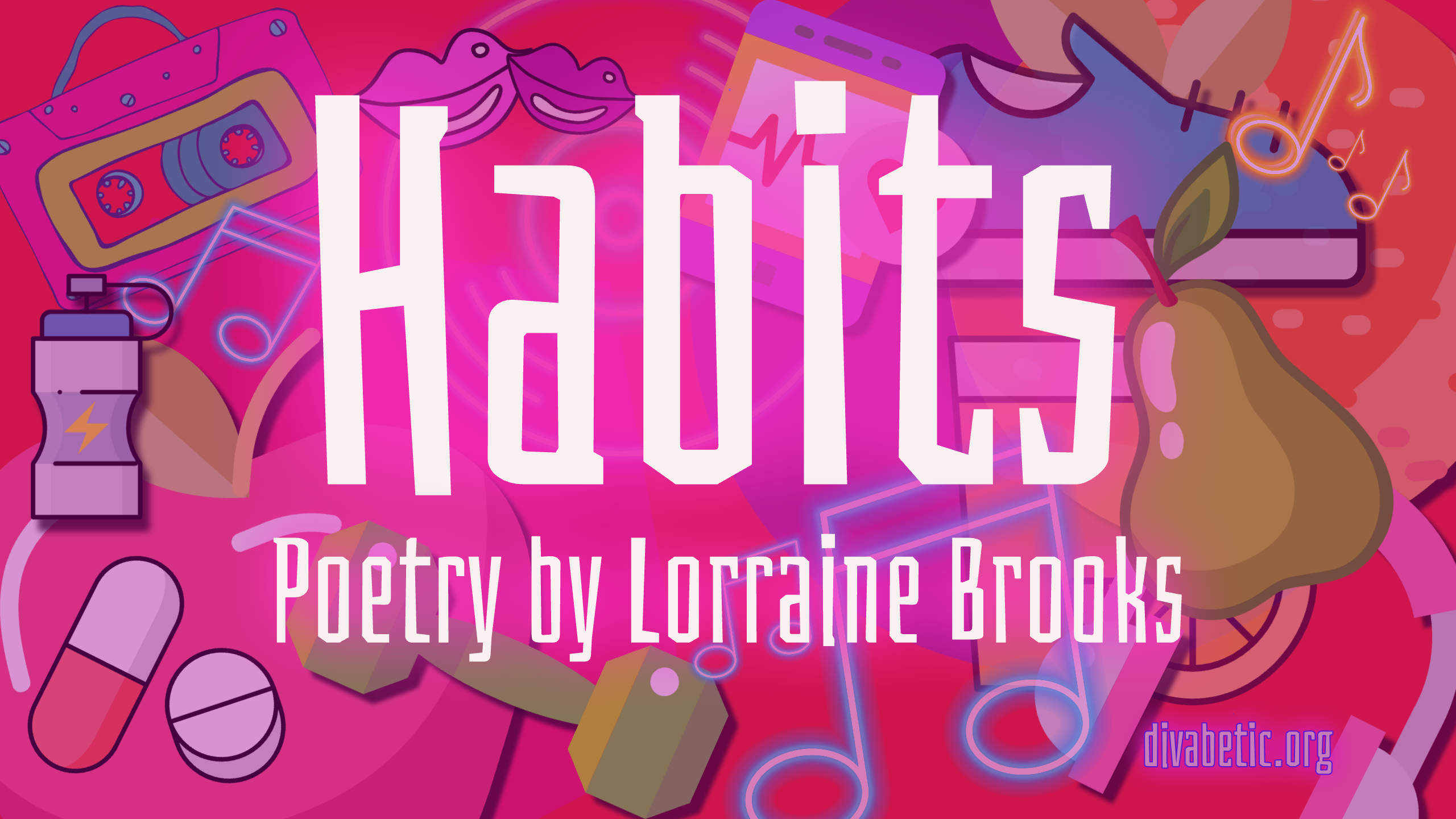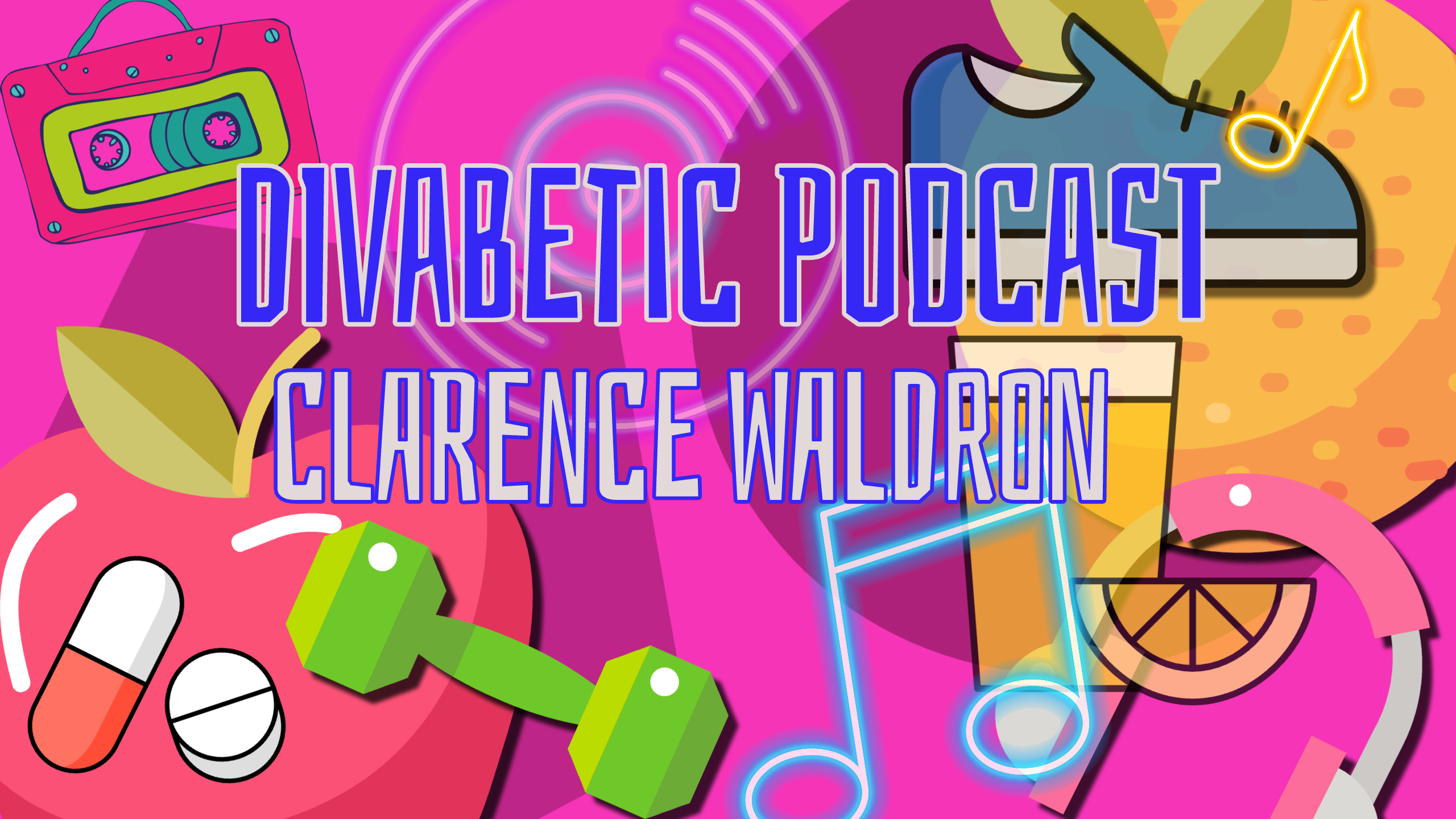Poet Lorraine Brooks shares her poem about habits on Divabetic‘s Healthy Swaps podcast. We’re offering simple ideas to help you live your best diabetes life on our podcast.We understand many people deal with diabetes distress and feel overwhelmed by the rentlessness of diabetes.Feeling this way about your diabetes is understandable and it’s a natural reaction for anyone that’s been diagnosed with a long-term health condition.
Lots of people feel like this sometimes but it’s important you get help. If you don’t get support to help you cope, you’re more likely to reach burnout and that can be really serious. Please let us join you on the journey.
Habits by Lorraine Brooks
To do somethig once
Doesn’t make a habit yetYou have to repeatSome habits are goodLike eating our vegetablesAnd counting our carbsBad habits die hard.Our chooices become lifestyles.And sometimes are poorWhat is a habitA behavior that binds usBut you can break freeTo age with kindnessCmes from having good habitsFrom when we are young.I dont mind agingBecause I have formed habits\That serve e well nowI’m aging like wineRich and mellow and sparklingMy habits paid offI know I’m OKI have worked hard to get hereAnd I will not quitBe Kind To Yourself
Try to manage your expectations about your blood sugar levels and A1c test results and set smaller, more realistic goals.
It also helps to stop using phrases like ‘good’ or ‘bad’ blood sugar – as this can constantly feel like you’ve done something wrong. Talk about high or low blood sugar instead.
Taking time for yourself, like booking a massage or setting an evening aside for a long bath can help you relax.
We’re sharing healthy swap ideas on this episode of Divabetic‘s podcast. With a few simple swaps, you can help live your best life while managing your diabetes. Our experts offer straightforward, simple, and fun swap ideas for drinks, medications, self-care, and fashion. Plus, we share style tips and words of inspiration to help you maintain a healthy habit.
Developing these habits isn’t always easy. Adapting to a new routine can be tricky, and it’s often tempting to want to return to old ways if we don’t see immediate results. One of the biggest mistakes people make when forming a new habit is taking on too much too quickly. Focus on what’s working in your diabetes self-care plan before overhauling diabetes management. Instead of decluttering the entire house, why not focus on one room or closet? Why not focus on the calories you drink rather than everything you eat? If you want to eat healthier, try replacing one dessert daily with a piece of fruit rather than cutting out sugar completely. If you’re going to get into hiking, start with a walk at lunchtime. Setting small goals you can achieve will help keep you motivated along the way.
Guests include Catherine Schuller, Poet Lorraine Brooks, Patricia Addie-Gentle RD, CDCES, MaryAnn Horst Nicolay, MEd, NDTR, and Mama Rose Marie. Hosted by Mr. Divabetic.
Clarence Waldron talks about his stroke, recovery, working as Senior Editor and Writer of Jet Magazine, and his memories of Luther Vandross and Aretha Franklin in this YouTube video. Twenty years ago, Clarence interviewed Luther’s mother, Mrs. Mary Ida Vandross, for Jet Magazine after Luther suffered a stroke due to mismanaged type 2 diabetes.
Luther Vandross’s Dance With My Father Celebrates 20th Year Anniversary
This year marks two decades since the release of Luther‘s soulful and emotional ballad “Dance with My Father.” It’s also the twentieth anniversary of Luther’s devastating stroke related to mismanaged type 2 diabetes. Luther suffered a stroke at age 52.
I found Luther on the floor of his Fifth Avenue apartment after he suffered a stroke. Many have speculated that Luther experienced the stroke several hours before my arrival. Sadly, his stroke damaged Luther’s motor skills and mental abilities, leaving him unable to perform on stage again.

At the time, I had no idea that mismanaged diabetes could cause such tragic health outcomes even though, I had a family history of diabetes. When the media reported that Luther suffered a stroke but failed to mention it’s linked to diabetes, I felt was angry. I wanted to warn Luther fans about the connection so they could avoid a similar fate. Luther’s stroke changed the course of my life. I became Lutehr’s caregiver, a passionate diabetes advocate, and the founder of the nonprofit, Divabetic. Every day I strive to help inspire and empower people with diabetes to take charge of their diabetes health. I know it’s not easy. Some days are more challenging than others, mainly when unexpected setbacks occur. But ignoring your diabetes is not the answer.
“Dance With My Father” is a testament to the power of mismanaged diabetes to decimate a family tree. Luther lost his father at a tender age due to mismanaged diabetes too.

I lost my father four years ago to bone cancer. I am grateful for the many years my father and I spent together working on Divabetic outreach. We saw the power of educating the generations in families to prevent diabetes health complications from occurring.
“Dance With My Father” is co-written by Luther Vandross and GRAMMY-winning singer, songwriter, and producer Richard Marx, and resonated with millions of listeners worldwide, touching hearts and earning Vandross a posthumous GRAMMY for Song of the Year in 2004.
https://youtu.be/OiNSRU-smNI
To honor Luther’s enduring music legacy, Primary Wave Music, The Luther Vandross Estate, and Legacy Recordings/Sony Music have released the song in high-resolution Dolby Atmos for an enhanced audio experience that fans can stream and download from several platforms.
Visit LutherVandross.com to create and share personally customized Father’s Day memories using the ‘What My Father Taught Me’ meme generator with the hashtag #DanceWithMyFather20. Additionally, on the site, you can purchase items from a limited edition gift guide, encapsulating the soul of this unforgettable song. Commemorate Father’s Day and Black Music Month by celebrating this iconic piece of Black music history. Let’s unite as fans, saluting Luther Vandross’ lasting legacy and the special connection between fathers and their children.
I will take every opportunity to raise awareness for diabetes and diabetes health-related complications such as stroke.
Senior Writer and Editor of Jet Magazine, Clarence Waldron, talks about his stroke and its recovery.
Twenty years ago, Clarence interviewed Luther’s mother, Mrs. Mary Ida Vandross, for Jet Magazine after Luther suffered a stroke due to mismanaged type 2 diabetes. Clarence’s story is an excellent reminder of why it’s essential to ACT F.A.S.T. if you or a loved one is experiencing a stroke. The acronym FAST (Facial drooping, Arm weakness, Speech difficulties, and Time) has been used by the National Stroke Association, American Heart Association, and others to educate the public on detecting stroke symptoms.
Earlier treatment results in a greater chance of recovery, a reduced likelihood of permanent disability, and a lesser need for extensive rehabilitation. You’ll quickly hear Clarence’s upbeat attitude and ferocious appetite for music and divas have served him well during his recovery.
Throughout this podcast, we feature music from Aretha Franklin’s Get It Right album and Luther Vandross’s Live At Radio City Music Hall 2003 20th Anniversary Edition album courtesy of SONY Music.
Easy, Grilled Asparagus Recipe
This is what happens when you serve Grilled Asparagus prepared on an Outdoor Grill – they’re gone within minutes!

I have an intense dislike of peas, but I love asparagus. It’s a good thing, too, because asparagus is rich in minerals and vitamins A, C, and folic acid. It’s a fibrous vegetable that may support a healthy gut, as well as help lower blood pressure.
So easy to make too. Clean, cut, and trim asparagus spears. I like to cut off the white ends – they’re dense and hard to chew. On some pencil-thine spears (harder to manage on the grill), the white woody ends may not tenderize once cooked. On larger stalks, those same ends never soften. However, it’s not necessary to trim asparagus.
The night before, tossed them with olive oil, salt, pepper, and lemon juice. Then grill the asparagus for 8-10 minutes over medium flame until soft, and add lemon zest before serving. Delicious!

We’re sharing a few simple swaps to help you live your best life while managing your diabetes on this episode of Divabetic’s podcast. Guests include Catherine Schuller, Poet Lorraine Brooks, Patricia Addie-Gentle RD, CDCES, MaryAnn Horst Nicolay, MEd, NDTR, and Mama Rose Marie. Hosted by Mr. Divabetic.
This podcast features music from Aretha Franklin’s Get It Right and Who’s Zooming Who albums courtesy of SONY Music
The happy healthcare host, Mr. Divabetic stops by the 10th annual Big Apple Barbecue Block Party at Madison Square Park in New York City. Hear how everyday people stay on track with their health goals while indulging in summertime fun.
Ben Vereen on Living Healthy With Type 2 Diabetes
“How are you feeling today? I hope you’re doing well and taking good care of yourself. ❤️ Remember to prioritize your well-being and find moments of joy in your day. Wishing you a wonderful day ahead filled with positivity and happiness,” 🙏🏾 posted Ben Vereen, living with type 2 diabetes, on social media. The Broadway legend often shares positive messages on social media to motivate and encourage people.
After the initial panic from his diagnosis lessened, he began to seek help. “Once my doctor told me what I had to do, I knew the regimen. He provided that comfort zone and made it very easy for me. I was able to maintain my performing schedule, I still do.”
In an interview with Diabetes Self-Management, Ben Vereen said, “The community has been so inspirational. Right after I was diagnosed, I had a show in Vegas. I thought, how am I gonna get through this? This is why we have to speak up. I get there and a stagehand I’ve worked with for years said, “I heard you have diabetes.” He said, “Don’t worry about this, you’ll get through it, I have diabetes, too. Many of us here have it — we’re gonna watch you.” Knowing someone else walking this path was comforting. I felt better knowing that if I had questions, I had someone I could turn to. As Patti LaBelle told me, “I have it, it doesn’t have me.”
Ben changed his eating plan. “I became a vegan, that’s what worked for me. I exercise, too, but I already did exercise so that was easy. My mantra: Everything in moderation. Moderation is key.”
He doesn’t adhere to a one size fits all mentality when it comes to managing diabetes but instead recommends tailoring self-care to meet your needs. “Do what works for you. Then share your story with the community so maybe someone with the same fear can be educated and not feel alone.”
Join us tonight for our Healthy Lifestyle Swaps podcast starting at 6 PM, EST.
With a few simple swaps, you can help live your best life while managing your diabetes. Our experts offer straightforward, simple, and fun swap ideas for drinks, medications, self-care, and fashion. Plus, we share style tips and words of inspiration to help you maintain a healthy habit.
Developing these habits isn’t always easy. Adapting to a new routine can be tricky, and it’s often tempting to want to return to old ways if we don’t see immediate results. One of the biggest mistakes people make when forming a new habit is taking on too much too quickly. Focus on what’s working in your diabetes self-care plan before overhauling diabetes management. Instead of decluttering the entire house, why not focus on one room or closet? Why not focus on the calories you drink rather than everything you eat? If you want to eat healthier, try replacing one dessert daily with a piece of fruit rather than cutting out sugar completely. If you’re going to get into hiking, start with a walk at lunchtime. Setting small goals you can achieve will help keep you motivated along the way.
Guests include Catherine Schuller, Poet Lorraine Brooks, Patricia Addie-Gentle RD, CDCES, MaryAnn Horst Nicolay, MEd, NDTR, and Mama Rose Marie. Hosted by Mr. Divabetic.
Please feel free to call-in comments at 1-347-215-8551. Diva TalkRadio’s signature show is one you want to hear live every month.
Sugar-Free Red Velvet Cake Squares Recipe by The Diabetic Pastry Chef
Sugar-Free Red Velvet Cake Squares Recipe by The Diabetic Pastry Chef
Ingredients
1 cup all-purpose flour
1 cup white whole-wheat flour
1 tsp baking powder
1 tsp baking soda
3/4 tsp salt
2 Tbsp. cocoa powder
2 cups sugar-substitute of your choice
3/4 cup vegetable oil
2 eggs
1 cup buttermilk
2 tsp pure vanilla extract
2 tsps. red food coloring
1 tsp vinegar
1/2 cup hot coffee
Ingredients
1 cup all-purpose flour
Directions
Combine all dry ingredients in a large bowl; set aside.
In the bowl with an electric mixer, combine sugar-substitute and vegetable oil. Add in the rest of the wet ingredients and mix well.
Add dry ingredients in thirds to wet ingredients, mixing just until combined.
Preheat oven to 350 degrees. Add batter to greased and floured 9×13″ pan. Bake for about 30 to 40 minutes, or until the cake pulls away from the sides of the pan and the center springs back when touched.
After cooling, sprinkle top with sugar-free confectioners sugar such as Swerve Confectioners. Serve cake cut into squares topped with whipped cream or whipped topping.

Although red velvet cake is generally linked with Valentine’s Day, it is also served at Juneteenth parties. For Juneteenth celebrations, the color red represents the struggle and bloodshed of the enslaved as well as the ultimate resilience of the people.
Clarence Waldron talks about his stroke, recovery, working as Senior Editor and Writer of Jet Magazine, and his memories of Luther Vandross and Aretha Franklin.
Twenty years ago, Clarence interviewed Luther’s mother, Mrs. Mary Ida Vandross, for Jet Magazine after Luther suffered a stroke due to mismanaged type 2 diabetes. Clarence’s story is an excellent reminder of why it’s essential to ACT F.A.S.T. if you or a loved one is experiencing a stroke. The acronym FAST (Facial drooping, Arm weakness, Speech difficulties, and Time) has been used by the National Stroke Association, American Heart Association, and others to educate the public on detecting stroke symptoms.
Earlier treatment results in a greater chance of recovery, a reduced likelihood of permanent disability, and a lesser need for extensive rehabilitation. You’ll quickly hear Clarence’s upbeat attitude and ferocious appetite for music and divas have served him well during his recovery.
Throughout this podcast, we feature music from Aretha Franklin’s Get It Right album and Luther Vandross’s Live At Radio City Music Hall 2003 20th Anniversary Edition album courtesy of SONY Music.
Sugar Substitutes, Gut Health and Type 2 Diabetes
The whole conversation around the risks of consuming sugar, added sugars, and artificial sugar substitutes is confusing for anyone, especially those with diabetes.
The health risks associated with consuming too much sugar in your foods and drinks are alarming. But sugar is sneaky. When you think you figured it out, you look closely at nutrition labels, only to discover manufacturers have ways of hiding sugar in foods and drinks marketed as ‘healthy.’

Divabetic Podcast on Stroke
On Divabetic’s podcast, Clarence Waldron shares his stroke, recovery, working as Senior Writer and Editor from Jet Magazine, and his memories of legends Luther Vandross and Aretha Franklin.
Twenty years ago, Clarence interviewed Luther’s mother, Mrs. Mary Ida Vandross, for Jet Magazine after Luther suffered a stroke due to mismanaged type 2 diabetes.
When I was growing up Jet Magazine was everywhere — barbershops, salons, and waiting rooms. The digest-size magazine featured pop culture stories, What’s On TV, Wedding Announcements and Anniversaries, the (in)famous Jet Beauty of the Week, and Jet’s Top 20 Singles.
Clarence’s story is an excellent reminder of why it’s essential to ACT F.A.S.T. if you or a loved one is experiencing a stroke. The acronym FAST (Facial drooping, Arm weakness, Speech difficulties, and Time) has been used by the American Stroke Association, American Heart Association, and others to educate the public on detecting stroke symptoms.
Earlier treatment results in a greater chance of recovery, a reduced likelihood of permanent disability, and a lesser need for extensive rehabilitation.
You’ll quickly hear Clarence’s upbeat attitude and ferocious appetite for music and divas have served him well during his recovery.
Throughout this podcast, we feature music from Aretha Franklin’s Get It Right album and Luther Vandross’s Live At Radio City Music Hall 2003 20th Anniversary Edition album courtesy of SONY Music.

Get It Right is Aretha Franklin’s twenty-ninth studio album, released in 1983 by Arista Records. It was produced by Luther Vandross, following his successful teaming with the singer for the Gold-certified album, Jump to It. Album highlights include I Wish It Would Rain, I Got Your Love, and Every Girl Wants My Guy.
Divabetic Podcast Inspired by Etta James
Etta James inspires this episode of Divabetic’s podcast.
After the six-time Grammy award winner conquered her drug addiction in 1988, she struggled with her weight. At the peak of her obesity, she reportedly weighed as much as 400 pounds. At just five foot three, this weight gain often left her bedbound, and when she did appear publicly, she was seen in a wheelchair. She was unable to perform during this period.
However, after successful gastric bypass surgery, she lost over 200 pounds and began to perform again.
She told Ebony Magazine in 2006 she could sing “lower, louder and longer” than before.
However, she still had enormous difficulty adjusting to her smaller stomach. “I had trouble keeping food down,” she said. Her mental health also suffered. “I went through a depression. You’re doing well, and then all of a sudden you’re not. I thought I was going to fail.”
Etta James’s openness about her frustrations in managing her weight after the surgery has helped other people cope with the same issues. It’s important to remember you’re not alone if you struggle with weight loss issues, depression, anxiety, or low self-esteem. You owe it to yourself to get comprehensive treatment for all your symptoms—including your mental health symptoms. Seek a referral to a mental health professional to get the treatment you need for any mental health issues you are dealing with.
As she entered her 70s, Etta James began struggling with health issues. She was hospitalized in 2010 for a blood infection and other ailments. It was later revealed that the legendary singer suffered from dementia and was receiving treatment for leukemia.
Opera, Puccini & Diabetes
Yesterday, my mother and I went to the Palmetto Opera‘s performance of Great Voices from Broadway to Opera for a belated Mother’s Day celebration. The program featured some of opera’s greatest arias, duets, and memorable songs from the Golden Age of Broadway. My mom loves Phantom of the Opera, and I love Turandot‘s Nessun Dorma and La Traviata‘s Sempre Libera, so it was a win-win for both of us.
The concert also featured two songs from Italian composer Giacomo Puccini‘s masterpiece, La Boheme (O Mimi, tu piu non torni, O soave fancuilla).
Giacomo Puccini was born in 1858 and later diagnosed with diabetes in 1908. Numerous reports mention that he struggled to manage his diagnosis for much of his life. Understandably, managing diabetes was difficult before the discovery of insulin wasn’t until 1921.
Before insulin was discovered in 1921, people with diabetes were put on very strict diets with minimal carbohydrate intake. Some doctors prescribed as little as 450 calories a day! Sadly, some people with diabetes died of starvation.
On this Divabetic podcast, we intersperse highlights of the history of diabetes, self-care treatments, and innovations for the past hundred years as we discuss Puccini’s artistry and life.
Divabetic podcast guests include Toby Smithson, MS, RDN, LD, CDCES, FAND, Patricia Addie-Gentle RN, CDCES. Hosted by Mr. Divabetic.
Throughout this podcast, we will feature music from Puccini: Great Opera Arias courtesy of SONY Music.
Giacomo Puccini’s artistic triumphs include La Bohème, Tosca, and Madama Butterfly. Unfortunately, his last opera, based on the fable of Turandot, would remain unfinished due to his death from throat cancer in Brussels in 1924.
Plus, we had the added treat of hearing the Theme from The Godfather and The Impossible Dream from Man Of La Mancha.
People with diabetes and their loved ones probably considered the discovery of insulin the impossible dream.
A young surgeon named Frederick Banting and his assistant Charles Best figured out how to remove insulin from a dog’s pancreas in 1921. They continued to experiment with dogs until January 1922. Leonard Thompson, a 14-year-old boy dying from diabetes in a Toronto hospital, was the first to receive an insulin injection. Within 24 hours, Leonard’s dangerously high blood glucose dropped to near-normal levels.
The news about insulin spread around the world like wildfire. In 1923, Banting and Macleod received the Nobel Prize in Medicine, which they shared with Best and Collip. Thank you, diabetes researchers!
My boss, Luther Vandross, who had type 2 diabetes, recorded The Impossible Dream for his Songs album. He performed it many times in concert to the thrill of audiences. Recently PBS aired his performance at Royal Albert Hall in London.

We’re discussing minimizing the drama in our diabetes lives with music from the ultimate diva, Maria Callas.
Maria Callas changed how we listen to opera—and charged the ambition of the singers who followed her. Her ability to interpret a wide variety of different roles truly set her apart, establishing her as a phenomenon, an operatic diva. She could fully exploit the dramatic strength of her low vocal range as much as the high and bright notes of her high range.
Opera takes any dramatic story and tries to make it more exciting and more believable with the help of music. Symptoms and situations related to diabetes are often dramatic and come on very suddenly. But how do you react to them? Are you a ‘drama queen’?
Whenever we are immersed in something overwhelming, we can learn how to deal with challenges better.
Divabetic podcast guests include Dr. Wendy Satin Rapaport LCSW, PsyD, Jill Weisenberger MS, RDN, CDCES, CHWC, FAND, Lorraine Brooks, American Heart and American Diabetes Association’s Know Diabetes By Heart Ambassador Rob Taub, Yoga for Diabetes Author and Director Rachel Zinman and Patricia Addie-Gentle RN, CDCES.
Throughout the podcast, we will feature music from the Grandiose Stimmen: Maria Callas album courtesy of SONY Music.
Happy Birthday Ella Fitzgerald!
Happy Birthday Ella Fitzgerald, on her 106th birthday!
Ella Fitzgerald was living with type 2 diabetes. Sadly, she had both of her legs amputated. But losing her limbs didn’t stop her from performing on stage. I think that’s a great testament to her strong will and determination.
There are still so many obstacles blocking people with disabilities from living their best life. I’m sure Ella Fitzgerald encountered many of them, from the smallest stair to the pity and scorn in people’s eyes. Week after week, traveling on the road from city to city to perform at night makes it difficult to maintain and sustain a health regimen, especially diabetes self-care. As someone who has traveled on the road supporting musician, I can easily understand how the rigors of touring can take a toll on your physical and mental health.
It’s easy for someone to write her off for not taking care of herself because it’s harder to admit how easy it is to ignore your diabetes. The number of people who don’t manage their diabetes dramatically outnumbers those who do.
Sadly, ignoring your diabetes leads to disastrous consequences. Mismanaged diabetes can lead to amputations, usually of the toes, feet, or legs. Causes include reduced blood flow or peripheral neuropathy. Managing your blood sugar is one way to help prevent it.
According to the National Institute of Diabetes and Digestive and Kidney Diseases (NIDDK)Trusted Source, about 130,000 people in the United States who have diabetes have amputations yearly.
Better diabetes management and foot care have caused lower limb amputations over the past 20 years. However, 2018 research suggests that young and middle-aged adults in the United States are experiencing an uptick in diabetes-related amputations.
With ongoing diabetes management, foot care, and wound care, many people with diabetes can limit their risk of amputation or prevent it entirely. Education is crucial.
We proudly celebrate the First Lady of Song and raise awareness for the greater need for diabetes education on this episode of Divabetic’s podcast with Patricia Addie-Gentle RN, CDCES, Susan Weiner MS, RDN, CDCES, CDN, Lorraine Brooks, Ansley Dalbo, Anna J. Stewart, and Leola and Cornelia.









